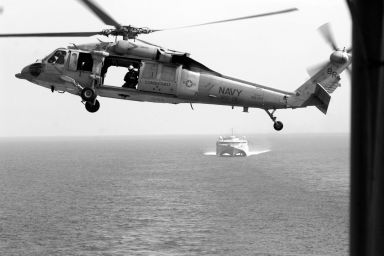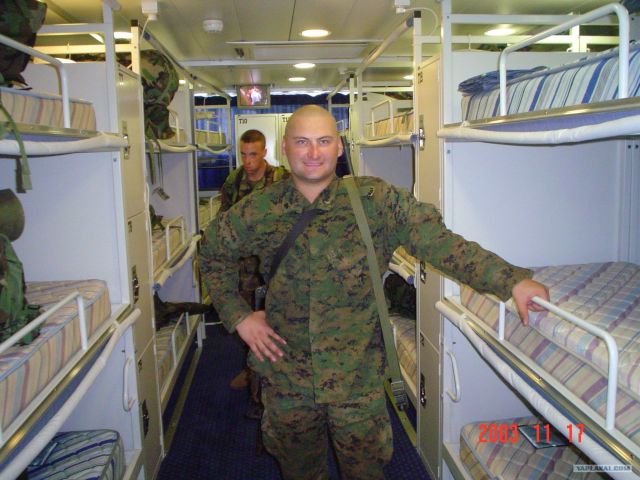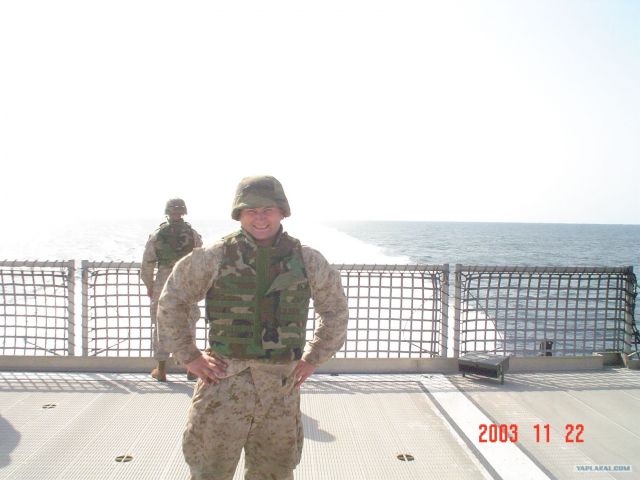-
![[image]](https://www.balancer.ru/cache/forums/attaches/2015/05/128x128-crop/10-3830339-mh-60-seahawk-with-hsv-2-swift.jpg)
HSV-2 Swift, скоростной гибридный катамаран
Теги:
Сообщение было перенесено из темы Новости иностранных ВМС.
July 2004
Navy Tests Coastal Warfare Systems Aboard New Catamaran
by Harold Kennedy
A new high-speed catamaran, just leased for $21.7 million, is helping the U.S. Navy decide what technologies will be most useful in coastal warfare.
The Navy is seeking to develop a new class of littoral combat ships, which will feature an advanced hull form and a shallow draft, and be able to move through coastal waters at speeds of 40 to 50 knots. In May, the service awarded contracts to two firms—$45.5 million to Lockheed Martin's Naval Electronics & Surveillance Systems of Moorestown, N.J., and $78.8 million to General Dynamics' Bath Iron Works, of Bath, Maine—to do final designs.
Lockheed Martin's design is expected to be completed by December of this year, and General Dynamics' work is to be done by September 2005. The contracts include options for construction of up to two prototype ships.
The high-speed catamaran is serving as a test platform for technologies in mine warfare and expeditionary operations that the Navy would like to transition to LCS.
The service’s latest catamaran—called the High Speed Vessel 2 Swift—is a converted car ferry. It is 321 feet long, with a top speed of about 45 knots.
The Swift’s aluminum hull draws only about 11.5 feet of water. This enables her to operate in shallow coastal waters, without the need for major harbors with deepwater berths, said the ship’s experimentation director, Lt. Cmdr. Paul Berthelotte.
The Swift was leased in August from Bollinger/Incat USA, of Lockport, La. It is the latest of several Australian catamarans to be put to use by U.S. military services. After watching an Australian Navy catamaran move troops and supplies to and from East Timor, the U.S. Marines in 2001 leased the WestPac Express from Austal Ships Pty.—an Australian rival of Incat—for use in the Western Pacific Ocean.
Also in 2001, the Army, Navy, Marines and Coast Guard leased the HSV-X1 Joint Venture from Bollinger/Incat for a year, with the possibility of another year’s extension.
The Army, looking for a platform that could move more troops and equipment, renewed the lease for the Joint Venture.
During the early days of the conflict with Iraq, the Joint Venture served as a forward staging platform for Marine Fleet Anti-Terrorism and Navy SEAL (Sea, Air and Land) units operating in the shallow waters off the port city of Um Qasr. In April of this year, Army aviators off the coast of Korea experimented with landing two UH-60 Black Hawk helicopters on its flight deck.
In 2002, the Army’s Tank-Automotive and Armaments Command ordered a second catamaran from Bollinger/Incat. The ship has been dubbed Theater Support Vessel Spearhead-X1. In 2003, the command decided to buy, rather than lease, several additional catamarans over the next few years. The catamarans would be built in the United States. The Army is preparing to award the first contract in 2005.
The Navy plans to explore the Swift’s ability to perform two primary missions—mine warfare command and support, and expeditionary operations, Berthelotte said.
The Swift, additionally, is serving with the Navy’s Mine Warfare Command, headquartered at Naval Station Ingleside, Texas, as the interim replacement for the Navy’s only mine countermeasures command and control ship, the USS Inchon, which retired in 2002.
It also is operating out of Naval Amphibious Base Little Creek, Va., in a series of expeditionary warfare experiments and exercises.
Two separate, 40-person crews operate the ship. A Gold Crew, based in Little Creek, concentrates on expeditionary missions, and a Blue Crew, in Ingleside, focuses on mine warfare. Both crews are made up entirely of volunteers, said the ship’s highest-ranking enlisted man, Senior Chief Petty Officer Lawrence Naumann. “A man waits his whole life for a ship like this,” he said. “Twenty seven of us served on the Joint Venture during the [Iraq] war.”
The ship’s experimental missions are accommodated, in large part, by its original design as a car ferry, with vast amounts of open space beneath her decks. She has a mission bay with 15,500 square feet of vehicle and module space, a vehicle ramp sturdy enough to accommodate M1A1 Abrams tanks, a crane that can launch and recover small boats and a 4,000-square-foot flight deck, with an adjacent hanger for two Sikorsky MH-60S Knighthawk helicopters.
A reconfigurable passenger compartment can seat up to 250 combat-equipped Marines in airline-style seats and provide 103 permanent sleeping berths.
The Swift has been equipped with a communications suite and the Lockheed Martin Integrated Combat Weapons System to perform command-and-control functions.
During a recent visit to Alexandria, Va., the Swift hosted a Knighthawk, the Navy’s newest combat search and rescue and naval special warfare helicopter. The MH-60S Knighthawk is testing new anti-mine sensors, said a pilot, Lt. Walt Bretton.
Sitting in the Swift’s hangar was a Fire Scout vertical takeoff and landing tactical unmanned air vehicle. Shipboard landing tests were scheduled to take place in the Chesapeake Bay in mid-June.
After Ingleside’s Blue Crew took possession of the vessel, she sped across the Indian Ocean to Bahrain, headquarters for the Navy’s 5th Fleet. There, Little Creek’s Gold Crew took over.
After crew certification by the Afloat Training Group in Bahrain, the ship set sail to join the West African Training Cruise 2004. During the cruise, the Swift worked with U.S. Marines and military personnel from seven West African nations, practicing coastal, and riverine and small boat operations.
Following completion of the West African cruise, the Swift delivered trucks, cranes, ambulances and construction equipment to U.S. military personnel conducting a humanitarian mission in Puerto Cortez, Honduras.
The Swift is able to cover vast distances of ocean quickly because of her so-called “wave-piercing” catamaran design, Incat officials said. Catamarans—twin-hulled vessels—have sailed the Indian Ocean for centuries. Incat updated the catamaran concept by using aluminum in its ship construction and powering the ships with four sets of marine diesel engines, gas turbines and water jets capable of throwing out 18 tons of water per second.
The Swift has an operating range of 1,100 nautical miles at an average speed of 35 knots and 4,000 nautical miles at 20 knots.
When the Navy agreed to lease the Swift, she was only 35 percent complete, Berthelotte said. This permitted the Navy to play a larger role in her design. The Navy requested four ovens and automatic dishwashers, explained galley captain Petty Officer 1st Class Bogan Burnett.
The Swift also has more weapons than its predecessors. It has a stabilized gun mount, the Mk 96 Mod 0, which is a two-axis weapon system that provides 25 mm chain-gun and 40 mm grenade machine-gun firepower. The vessel also carries the Mk 45 Mod O weapon mount, made by United Defense. The Mk 45 can accommodate both machine guns and grenade launchers.
The Swift was headed for NATO exercises off Norway, before returning to Little Creek.
http://www.nationaldefensemagazine.org/article.cfm?Id=1504
Navy Tests Coastal Warfare Systems Aboard New Catamaran
by Harold Kennedy
A new high-speed catamaran, just leased for $21.7 million, is helping the U.S. Navy decide what technologies will be most useful in coastal warfare.
The Navy is seeking to develop a new class of littoral combat ships, which will feature an advanced hull form and a shallow draft, and be able to move through coastal waters at speeds of 40 to 50 knots. In May, the service awarded contracts to two firms—$45.5 million to Lockheed Martin's Naval Electronics & Surveillance Systems of Moorestown, N.J., and $78.8 million to General Dynamics' Bath Iron Works, of Bath, Maine—to do final designs.
Lockheed Martin's design is expected to be completed by December of this year, and General Dynamics' work is to be done by September 2005. The contracts include options for construction of up to two prototype ships.
The high-speed catamaran is serving as a test platform for technologies in mine warfare and expeditionary operations that the Navy would like to transition to LCS.
The service’s latest catamaran—called the High Speed Vessel 2 Swift—is a converted car ferry. It is 321 feet long, with a top speed of about 45 knots.
The Swift’s aluminum hull draws only about 11.5 feet of water. This enables her to operate in shallow coastal waters, without the need for major harbors with deepwater berths, said the ship’s experimentation director, Lt. Cmdr. Paul Berthelotte.
The Swift was leased in August from Bollinger/Incat USA, of Lockport, La. It is the latest of several Australian catamarans to be put to use by U.S. military services. After watching an Australian Navy catamaran move troops and supplies to and from East Timor, the U.S. Marines in 2001 leased the WestPac Express from Austal Ships Pty.—an Australian rival of Incat—for use in the Western Pacific Ocean.
Also in 2001, the Army, Navy, Marines and Coast Guard leased the HSV-X1 Joint Venture from Bollinger/Incat for a year, with the possibility of another year’s extension.
The Army, looking for a platform that could move more troops and equipment, renewed the lease for the Joint Venture.
During the early days of the conflict with Iraq, the Joint Venture served as a forward staging platform for Marine Fleet Anti-Terrorism and Navy SEAL (Sea, Air and Land) units operating in the shallow waters off the port city of Um Qasr. In April of this year, Army aviators off the coast of Korea experimented with landing two UH-60 Black Hawk helicopters on its flight deck.
In 2002, the Army’s Tank-Automotive and Armaments Command ordered a second catamaran from Bollinger/Incat. The ship has been dubbed Theater Support Vessel Spearhead-X1. In 2003, the command decided to buy, rather than lease, several additional catamarans over the next few years. The catamarans would be built in the United States. The Army is preparing to award the first contract in 2005.
The Navy plans to explore the Swift’s ability to perform two primary missions—mine warfare command and support, and expeditionary operations, Berthelotte said.
The Swift, additionally, is serving with the Navy’s Mine Warfare Command, headquartered at Naval Station Ingleside, Texas, as the interim replacement for the Navy’s only mine countermeasures command and control ship, the USS Inchon, which retired in 2002.
It also is operating out of Naval Amphibious Base Little Creek, Va., in a series of expeditionary warfare experiments and exercises.
Two separate, 40-person crews operate the ship. A Gold Crew, based in Little Creek, concentrates on expeditionary missions, and a Blue Crew, in Ingleside, focuses on mine warfare. Both crews are made up entirely of volunteers, said the ship’s highest-ranking enlisted man, Senior Chief Petty Officer Lawrence Naumann. “A man waits his whole life for a ship like this,” he said. “Twenty seven of us served on the Joint Venture during the [Iraq] war.”
The ship’s experimental missions are accommodated, in large part, by its original design as a car ferry, with vast amounts of open space beneath her decks. She has a mission bay with 15,500 square feet of vehicle and module space, a vehicle ramp sturdy enough to accommodate M1A1 Abrams tanks, a crane that can launch and recover small boats and a 4,000-square-foot flight deck, with an adjacent hanger for two Sikorsky MH-60S Knighthawk helicopters.
A reconfigurable passenger compartment can seat up to 250 combat-equipped Marines in airline-style seats and provide 103 permanent sleeping berths.
The Swift has been equipped with a communications suite and the Lockheed Martin Integrated Combat Weapons System to perform command-and-control functions.
During a recent visit to Alexandria, Va., the Swift hosted a Knighthawk, the Navy’s newest combat search and rescue and naval special warfare helicopter. The MH-60S Knighthawk is testing new anti-mine sensors, said a pilot, Lt. Walt Bretton.
Sitting in the Swift’s hangar was a Fire Scout vertical takeoff and landing tactical unmanned air vehicle. Shipboard landing tests were scheduled to take place in the Chesapeake Bay in mid-June.
After Ingleside’s Blue Crew took possession of the vessel, she sped across the Indian Ocean to Bahrain, headquarters for the Navy’s 5th Fleet. There, Little Creek’s Gold Crew took over.
After crew certification by the Afloat Training Group in Bahrain, the ship set sail to join the West African Training Cruise 2004. During the cruise, the Swift worked with U.S. Marines and military personnel from seven West African nations, practicing coastal, and riverine and small boat operations.
Following completion of the West African cruise, the Swift delivered trucks, cranes, ambulances and construction equipment to U.S. military personnel conducting a humanitarian mission in Puerto Cortez, Honduras.
The Swift is able to cover vast distances of ocean quickly because of her so-called “wave-piercing” catamaran design, Incat officials said. Catamarans—twin-hulled vessels—have sailed the Indian Ocean for centuries. Incat updated the catamaran concept by using aluminum in its ship construction and powering the ships with four sets of marine diesel engines, gas turbines and water jets capable of throwing out 18 tons of water per second.
The Swift has an operating range of 1,100 nautical miles at an average speed of 35 knots and 4,000 nautical miles at 20 knots.
When the Navy agreed to lease the Swift, she was only 35 percent complete, Berthelotte said. This permitted the Navy to play a larger role in her design. The Navy requested four ovens and automatic dishwashers, explained galley captain Petty Officer 1st Class Bogan Burnett.
The Swift also has more weapons than its predecessors. It has a stabilized gun mount, the Mk 96 Mod 0, which is a two-axis weapon system that provides 25 mm chain-gun and 40 mm grenade machine-gun firepower. The vessel also carries the Mk 45 Mod O weapon mount, made by United Defense. The Mk 45 can accommodate both machine guns and grenade launchers.
The Swift was headed for NATO exercises off Norway, before returning to Little Creek.
http://www.nationaldefensemagazine.org/article.cfm?Id=1504
Сообщение было перенесено из темы Боевые корабли разных стран.
а вот это что за жуть такая ?
Прикреплённые файлы:
Evgen> а вот это что за жуть такая ?
Быстроходный транспорт как быстроходный транспорт, не все же одними королевами пользоваться. Это все творчество юных - австралийцы самовыражаются - HSV-2 Swift - Wikipedia, the free encyclopedia
// www.defenseindustrydaily.com
Быстроходный транспорт как быстроходный транспорт, не все же одними королевами пользоваться. Это все творчество юных - австралийцы самовыражаются - HSV-2 Swift - Wikipedia, the free encyclopedia
JHSV Fast Catamaran Transport Program Moves Forward
Hawaii Superferries to supplement JHSV; Cut to program. (Jan 26/12) When moving whole units, shipping is always the cheaper, (Last update: 2012-01-30 13:18:18 GMT)// www.defenseindustrydaily.com
Сообщение было перенесено из темы Современный Черноморский флот.
Capt(N)> Экспериментальный военный корабль США "HSV 2 SWIFT"....
Экспериментальный? С виду так в Европе это обычные скоростные паромы
Экспериментальный? С виду так в Европе это обычные скоростные паромы


Сообщение было перенесено из темы ВМС США [вторая половина ХХ века и современность...2].
Не забыты и подобные эксклюзивы!
KEY WEST, Florida (April 23, 2013) A tethered TIF-25K aerostat is positioned on the Military Sealift Command high-speed vessel Swift (HSV 2) ...
Отсюда: http://www.strategypage.com/.../military_photos_20130423214837.aspx
KEY WEST, Florida (April 23, 2013) A tethered TIF-25K aerostat is positioned on the Military Sealift Command high-speed vessel Swift (HSV 2) ...
Отсюда: http://www.strategypage.com/.../military_photos_20130423214837.aspx


Сообщение было перенесено из темы ВМС США [вторая половина ХХ века и современность...2].
HSV-2 Swift
Прикреплённые файлы:


sam7> HSV-2 Swift
Да уж футуристы эти американцы , любят необычную корабельную архитектуру.
Да уж футуристы эти американцы , любят необычную корабельную архитектуру.



Сообщение было перенесено из темы Хуситы поразили катамаран ОАЭ HSV-2 Swift .

Глазами русско-американского Морпеха США - ЯПлакалъ
Регистрация и вход Крутой поиск баянов О сайте Активные темы Помощь Правила Реклама Регистрация и вход Крутой поиск баянов О сайте Активные темы Помощь Правила Реклама Регистрация и вход Регистрация и вход Крутой поиск баянов О сайте Активные темы Помощь Правила Реклама Крутой поиск баянов О сайте Активные темы Помощь Правила Реклама Разделы Лента Общение Хаос ИнкубаторАртЯП Файлы Новый пост Разделы Лента Общение Хаос ИнкубаторАртЯП Файлы Новый пост Главная » Разделы » Лента » Картинки… // Дальше — www.yaplakal.comНебольшой фотоотчет с этого катамарана
Загрузка на корабль - HSV-2 "SWIFT" Высокоскоростной военный экспериментальный катамаран
Зона отдыха / столовая. Авиакресла, телевизоры под потолком, вид на океан на скорости 70-80 км/ч. Зашибись...
"Оружейная" - каждый, своим тросом и замком приковал свою винтовку к стене и как бы всё...
На передней открытой палубе - место для курения...
И я тут... И М2 пулемёт...


Это сообщение редактировалось 13.10.2016 в 09:42
Balancer:
Не про поражение.; предупреждение (+1) по категории «Флуд или офтопик»
Рекламное видео
SUPER FAST US Navy HSV 2 Swift Catamaran
The United States Navy (USN) is the naval warfare service branch of the United States Armed Forces and one of the seven uniformed services of the United States. It is larger than the next 13 largest navies combined in terms of battle fleet tonnage, according to one estimate.[5][6] The U.S. Navy also has the world's largest carrier fleet, with 10 in service, one under construction (two planned), and two in reserve.
SUPER FAST US Navy HSV 2 Swift Catamaran
The United States Navy (USN) is the naval warfare service branch of the United States Armed Forces and one of the seven uniformed services of the United States. It is larger than the next 13 largest navies combined in terms of battle fleet tonnage, according to one estimate.[5][6] The U.S. Navy also has the world's largest carrier fleet, with 10 in service, one under construction (two planned), and two in reserve.


- Balancer [09.11.2016 09:31]: Тема создана из ВМС США [вторая половина ХХ века и современность...2]
- Balancer [09.11.2016 09:32]: Перенос сообщений из Новости иностранных ВМС
- Balancer [09.11.2016 09:32]: Перенос сообщений из Боевые корабли разных стран
- Balancer [09.11.2016 09:33]: Перенос сообщений из Современный Черноморский флот
- Balancer [09.11.2016 09:34]: Перенос сообщений из ВМС США [вторая половина ХХ века и современность...2]
- Balancer [09.11.2016 09:35]: Перенос сообщений из Хуситы поразили катамаран ОАЭ HSV-2 Swift
madmat> Не американцы а австралийцы. Это их фишка.
Да посмотрел действительно они,но склонностью к необычной корабельной архитектуре страдают не только австралийцы.
Да посмотрел действительно они,но склонностью к необычной корабельной архитектуре страдают не только австралийцы.



- Последние действия над темой
- Balancer [09.11.2016 09:31]: Тема создана из ВМС США [вторая половина ХХ века и современность...2]
- Balancer [09.11.2016 09:32]: Перенос сообщений из Новости иностранных ВМС
- Balancer [09.11.2016 09:32]: Перенос сообщений из Боевые корабли разных стран
- Balancer [09.11.2016 09:33]: Перенос сообщений из Современный Черноморский флот
- Balancer [09.11.2016 09:34]: Перенос сообщений из ВМС США [вторая половина ХХ века и современность...2]
- Balancer [09.11.2016 09:35]: Перенос сообщений из Хуситы поразили катамаран ОАЭ HSV-2 Swift
- Все действия над темой
Copyright © Balancer 1997..2024
Создано 22.06.2004
Связь с владельцами и администрацией сайта: anonisimov@gmail.com, rwasp1957@yandex.ru и admin@balancer.ru.
Создано 22.06.2004
Связь с владельцами и администрацией сайта: anonisimov@gmail.com, rwasp1957@yandex.ru и admin@balancer.ru.
 Andrew_han
Andrew_han

 инфо
инфо инструменты
инструменты



 k_wal
k_wal





 Bilial
Bilial

 PSS
PSS
















 Novice1975
Novice1975








 Bilial
Bilial
